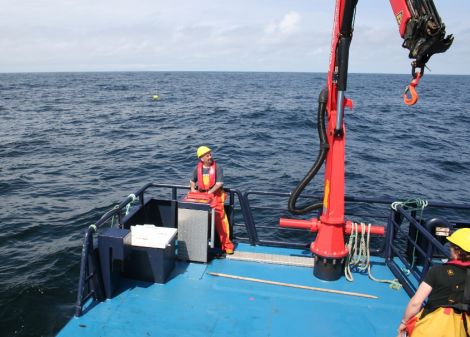News / Viking optimistic over transmission charges
SHETLAND wind farm developers Viking Energy hope to start raising the £700 million needed to build the controversial 127 turbine development next spring.
Project manager Aaron Priest attended a meeting in Glasgow on Thursday hosted by energy regulator Ofgem, who said they intend to set a new charging regime for transmitting electricity by 1 April 2012.
Stable transmission charges must be in place before financial institutions invest an estimated £560 million into the project to build the 457 megawatt wind farm.
Scottish and Southern Energy’s transmission arm SHETL must also raise £500 million for the subsea interconnector to export the electricity Viking generates.
The 600MW cable will allow further renewable energy developments in Shetland, like the 10MW wave farm off Burra planned by Aegir Wave Power, who launched a test buoy off St Ninian’s Isle this week.
The Ofgem meeting took place on the same day the Scottish government published their Renewables Routemap, an action plan on turning Scotland into “the green powerhouse of Europe” –
http://www.scotland.gov.uk/Resource/Doc/917/0118728.pdf.
The SNP government say Scotland should be able to generate the equivalent of all the electricity it consumes from renewables by 2020, one of the most ambitious targets in the world.
Their plan includes a commitment to expand onshore wind energy. Viking Energy is one of 100 onshore wind farms in the planning stage, but makes up one seventh of the 3.5 gigawatts they would generate if they all go ahead.
The government has delayed making any decision on the consent for Viking Energy until August so that arguments with Scottish Natural Heritage over its likely impact on the local population of whimbrel can be resolved.
One option will be to call a public inquiry, which would satisfy the 2,700 people who have objected to the plan. A further 1,100 have expressed support.
Become a member of Shetland News
Mr Priest said that after obtaining consent, the next major milestone for the Viking project that started life eight years ago will be setting transmission charges.
Currently the wind farm would have to pay £100 per kilowatt to export power to the national grid, compared to £21/KW in the north of Scotland and £1/KW in south east England. A power company generating electricity in south west England would actually be paid to transmit power, Mr Priest said.
“At the moment it would be cheaper to transmit renewable energy to the UK mainland from south west Ireland than it would be from Scotland,” he said.
Large power companies are keen to retain the status quo, but the growing renewables industry and the political drive to reduce carbon emissions are likely to push transmission charges in Shetland’s favour.
Ofgem admits the timetable is challenging, but have set up two working groups to look at different models for change which must report by autumn so a new system can be finalised by December for introduction in April.
If the new charging regime is still unfavourable for the Scottish islands, the UK government’s Department of Energy and Climate Change has reserved the power to cap transmission charges for Shetland, Orkney and the western isles.
Mr Priest said: “There is a clear expectation that we will have a stable, simple and predictable transmission charging regime by next year after which we hope to start concentrating on raising the finance for the wind farm.”
Banks, including Lloyds, have already expressed enthusiasm for Viking Energy and financial institutions are expected to pay 80 per cent of the construction cost.
Joint owner Shetland Charitable Trust expects to have to borrow £30-35 million to fund its initial direct investment, which they hope will eventually deliver returns of £23 million every year over a quarter of a century.
In its Renewables Routemap, the Scottish government aims to generate 500MW of community and locally owned green electricity by 2020.
It also speaks of a commitment to microgeneration, agri-renewables and a Green Equity Fund to support community renewable projects.
The government is predicting £30 billion investment in renewable energy will create 40,000 jobs. They also hope to see energy demand reduced by 12 per cent.
The report adds: “Renewable energy targets can not be met in the face of public opposition but only with the support and will of the Scottish public, gained through early and meaningful engagement on commercial schemes, and access to benefits – including the scope to develop community-owned schemes.”
Become a member of Shetland News
Shetland News is asking its many readers to consider paying for membership to get additional features and services: -
- Remove non-local ads;
- Bookmark posts to read later;
- Exclusive curated weekly newsletter;
- Hide membership messages;
- Comments open for discussion.
If you appreciate what we do and feel strongly about impartial local journalism, then please become a member of Shetland News by either making a single payment, or setting up a monthly, quarterly or yearly subscription.




























































